tire type Acura MDX 2017 Owner's Guide
[x] Cancel search | Manufacturer: ACURA, Model Year: 2017, Model line: MDX, Model: Acura MDX 2017Pages: 170, PDF Size: 12.43 MB
Page 3 of 170
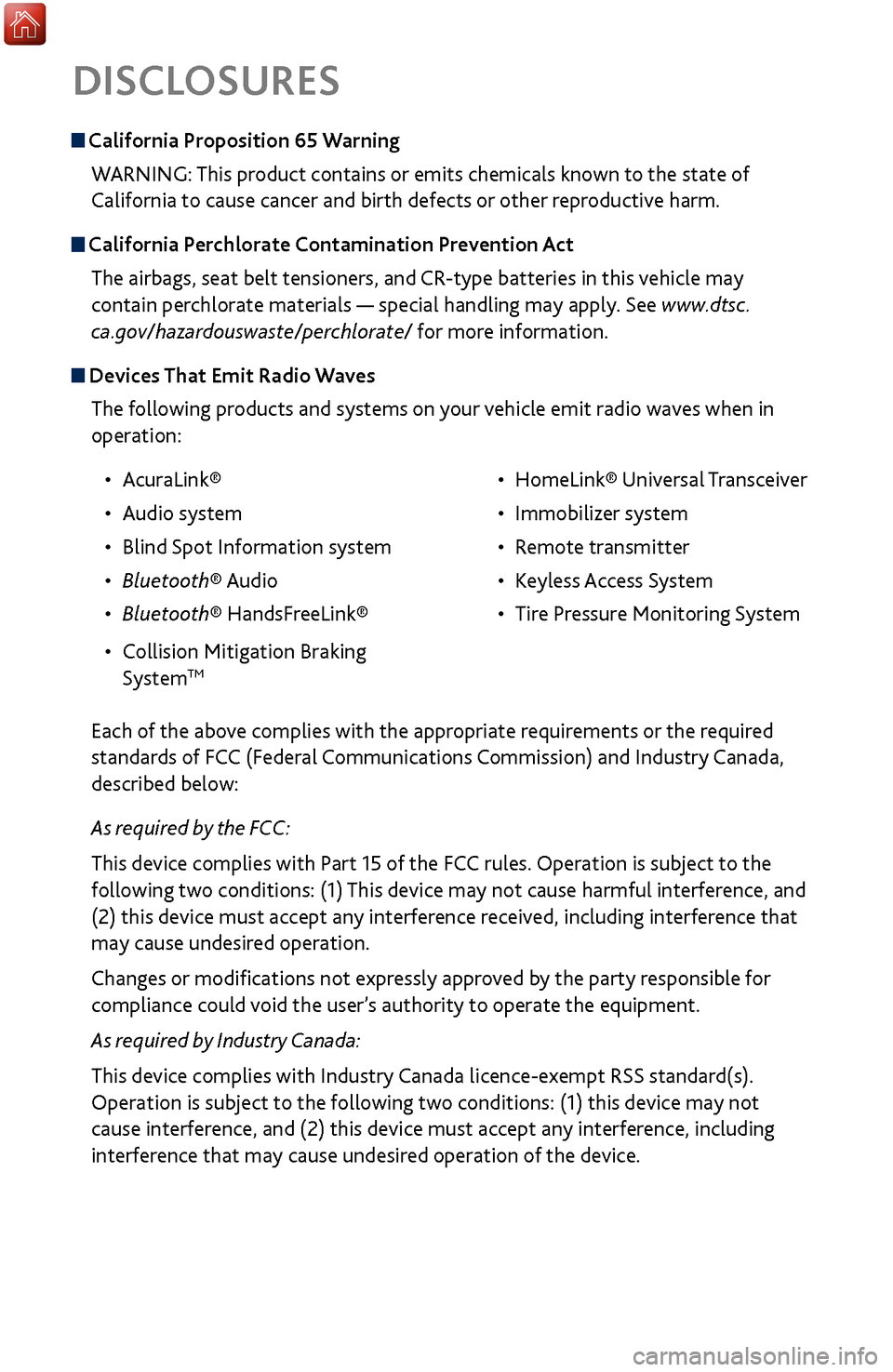
DISCLOSURES
California Proposition 65 WarningWARNING: This product contains or emits chemicals known to the state of
California to cause cancer and birth defects or other reproductive harm.
California Perchlorate Contamination Prevention ActThe airbags, seat belt tensioners, and CR-type batteries in this vehicle may
contain perchlorate materials — special handling may apply. See www.dtsc.
ca.gov/hazardouswaste/perchlorate/ for more information.
Devices That Emit Radio WavesThe following products and systems on your vehicle emit radio waves when in
operation:
•
AcuraLink®
•
Audio system
•
Blind Spot Information system
•
Bluetooth® Audio
•
Bluetooth® HandsF
reeLink®
•
Collision Mitigation Braking
SystemTM
• HomeLink® Universal T ransceiver
•
Immobilizer system
•
Remote transmitter
•
Keyless Access
System
•
Tire Pressur
e Monitoring System
Each of the above complies with the appropriate requirements or the required
standards of FCC (Federal Communications Commission) and Industry Canada,
described below:
As required by the FCC:
This device complies with Part 15 of the FCC rules. Operation is subject to the
following two conditions: (1) This device may not cause harmful interference, and
(2) this device must accept any interference received, including interference that
may cause undesired operation.
Changes or modifications not expressly approved by the party responsible for
compliance could void the user’s authority to operate the equipment.
As required by Industry Canada:
This device complies with Industry Canada licence-exempt RSS standard(s).
Operation is subject to the following two conditions: (1) this device may not
cause interference, and (2) this device must accept any interference, including
interference that may cause undesired operation of the device.
Page 109 of 170
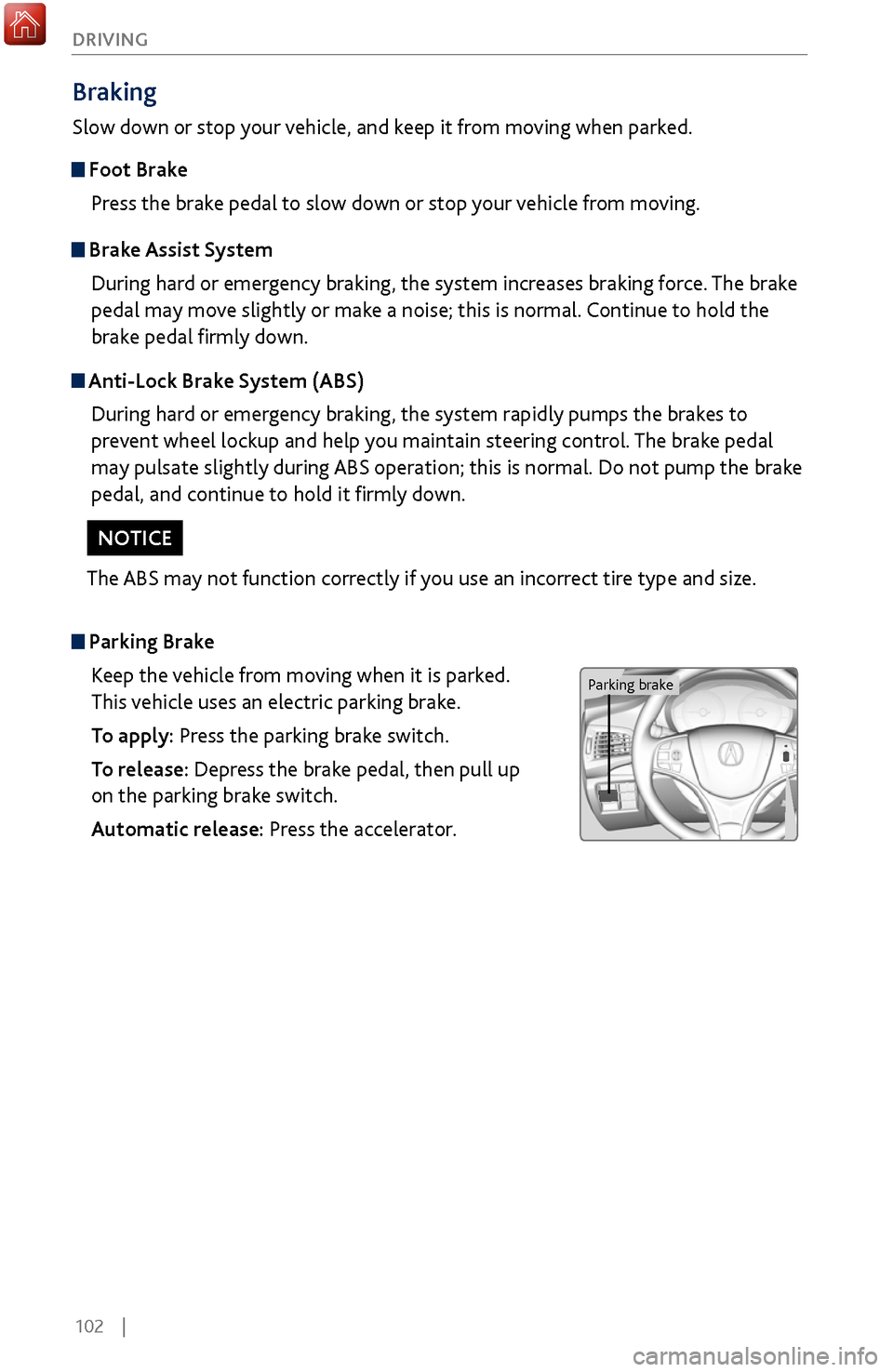
102 |
DRIVING
Braking
Slow down or stop your vehicle, and keep it from moving when parked.
Foot Brake
Press the brake pedal to slow down or stop your vehicle from moving.
Parking BrakeKeep the vehicle from moving when it is parked.
This vehicle uses an electric parking brake.
To apply: Press the parking brake switch.
To release: Depress the brake pedal, then pull up
on the parking brake switch.
Automatic release: Press the accelerator.
Brake Assist SystemDuring hard or emergency braking, the system increases braking force. The brake
pedal may move slightly or make a noise; this is normal. Continue to hold the
brake pedal firmly down.
Anti-Lock Brake System (ABS)During hard or emergency braking, the system rapidly pumps the brakes to
prevent wheel lockup and help you maintain steering control. The brake pedal
may pulsate slightly during ABS operation; this is normal. Do not pump the brake
pedal, and continue to hold it firmly down.
The ABS may not function correctly if you use an incorrect tire type and size.
NOTICE
Parking brake
Page 153 of 170
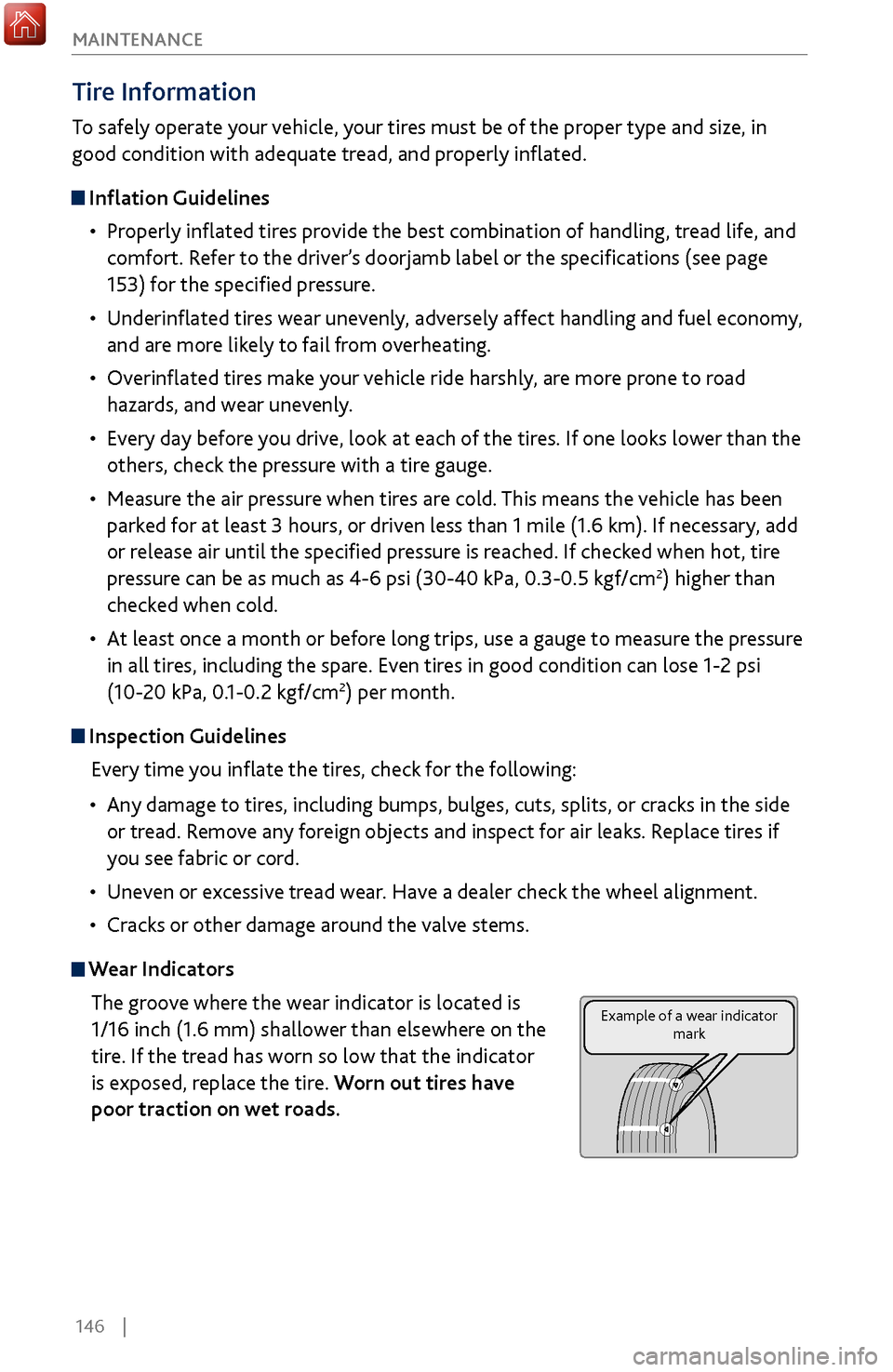
146 |
MAINTENANCE
Tire Information
To safely operate your vehicle, your tires must be of the proper type and size, in
good condition with adequate tread, and properly inflated.
Inflation Guidelines
•
Properly inflated
tires provide the best combination of handling, tread life, and
comfort. Refer to the driver’s doorjamb label or the specifications (see page
153) for the specified pressure.
•
Underinflated tires
wear unevenly, adversely affect handling and fuel economy,
and are more likely to fail from overheating.
•
Overinflated tir
es make your vehicle ride harshly, are more prone to road
hazards, and wear unevenly.
•
Every day befor
e you drive, look at each of the tires. If one looks lower than the
others, check the pressure with a tire gauge.
•
Measure the air pr
essure when tires are cold. This means the vehicle has been
parked for at least 3 hours, or driven less than 1 mile (1.6 km). If necessary, add
or release air until the specified pressure is reached. If checked when hot, tire
pressure can be as much as 4-6 psi (30-40 kPa, 0.3-0.5 kgf/cm
2) higher than
checked when cold.
•
At least once a month
or before long trips, use a gauge to measure the pressure
in all tires, including the spare. Even tires in good condition can lose 1-2 psi
(10-20 kPa, 0.1-0.2 kgf/cm
2) per month.
Inspection Guidelines
Every time you inflate the tires, check for the following:
•
Any damage
to tires, including bumps, bulges, cuts, splits, or cracks in the side
or tread. Remove any foreign objects and inspect for air leaks. Replace tires if
you see fabric or cord.
•
Uneven or ex
cessive tread wear. Have a dealer check the wheel alignment.
•
Cracks or other damage around the
valve stems.
Wear IndicatorsThe groove where the wear indicator is located is
1/16 inch (1.6 mm) shallower than elsewhere on the
tire. If the tread has worn so low that the indicator
is exposed, replace the tire. Worn out tires have
poor traction on wet roads.
Example of a wear indicator mark
Page 154 of 170
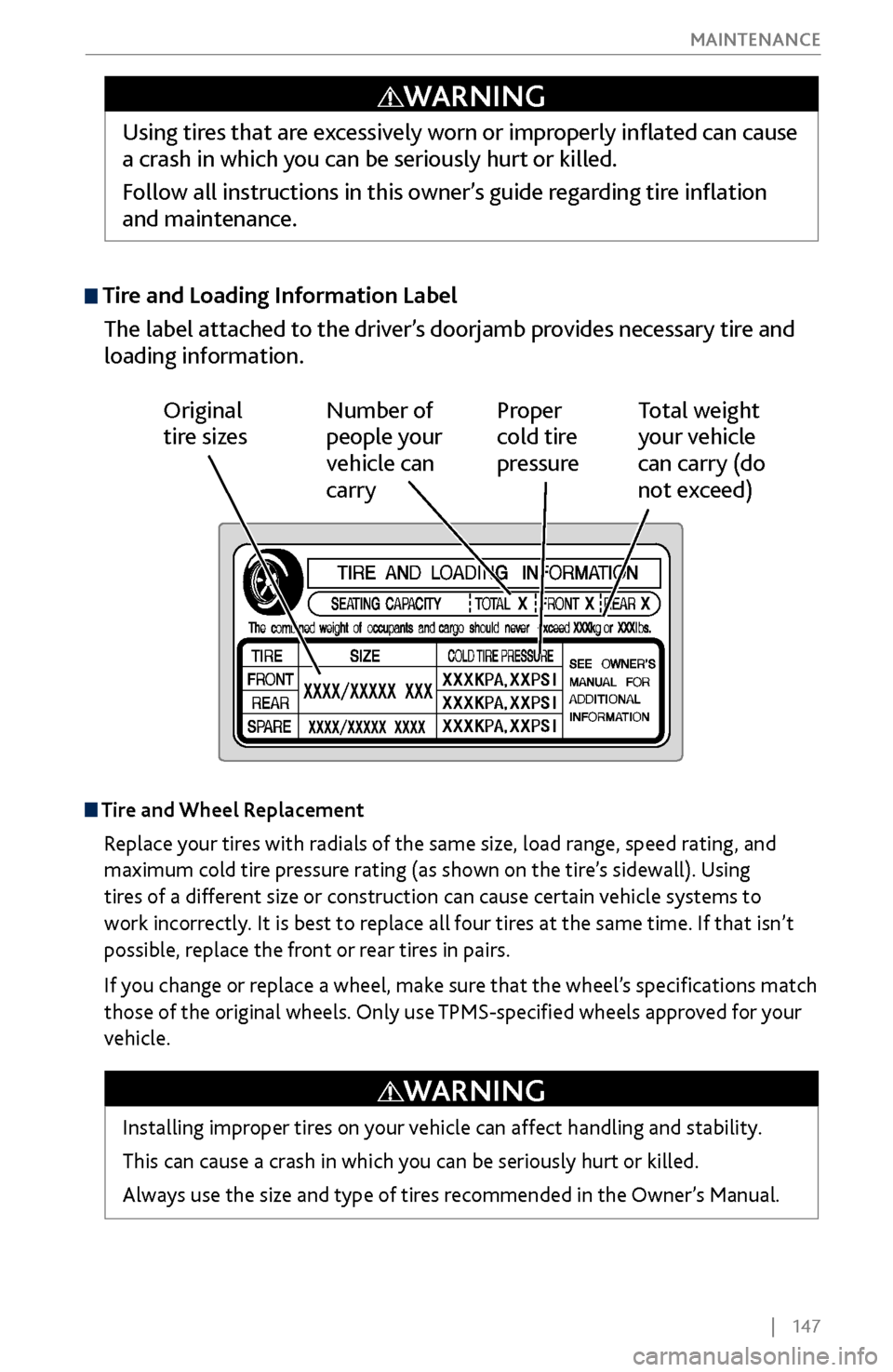
| 147
MAINTENANCE
Tire and Loading Information Label
The label attached to the driver’s doorjamb provides necessary tire and
loading information.
Original
tire sizes Number of
people your
vehicle can
carry Proper
cold tire
pressure
Total weight
your vehicle
can carry (do
not exceed)
Tire and Wheel Replacement
Replace your tires with radials of the same size, load range, speed rating, and
maximum cold tire pressure rating (as shown on the tire’s sidewall). Using
tires of a different size or construction can cause certain vehicle systems to
work incorrectly. It is best to replace all four tires at the same time. If that isn’t
possible, replace the front or rear tires in pairs.
If you change or replace a wheel, make sure that the wheel’s specifications match
those of the original wheels. Only use TPMS-specified wheels approved for your
vehicle.
Using tires that are excessively worn or improperly inflated can cause
a crash in which you can be seriously hurt or killed.
Follow all instructions in this owner’s guide regarding tire inflation
and maintenance.
WARNING
Installing improper tires on your vehicle can affect handling and stability.
This can cause a crash in which you can be seriously hurt or killed.
Always use the size and type of tires recommended in the Owner’s Manual.
WARNING
Page 155 of 170
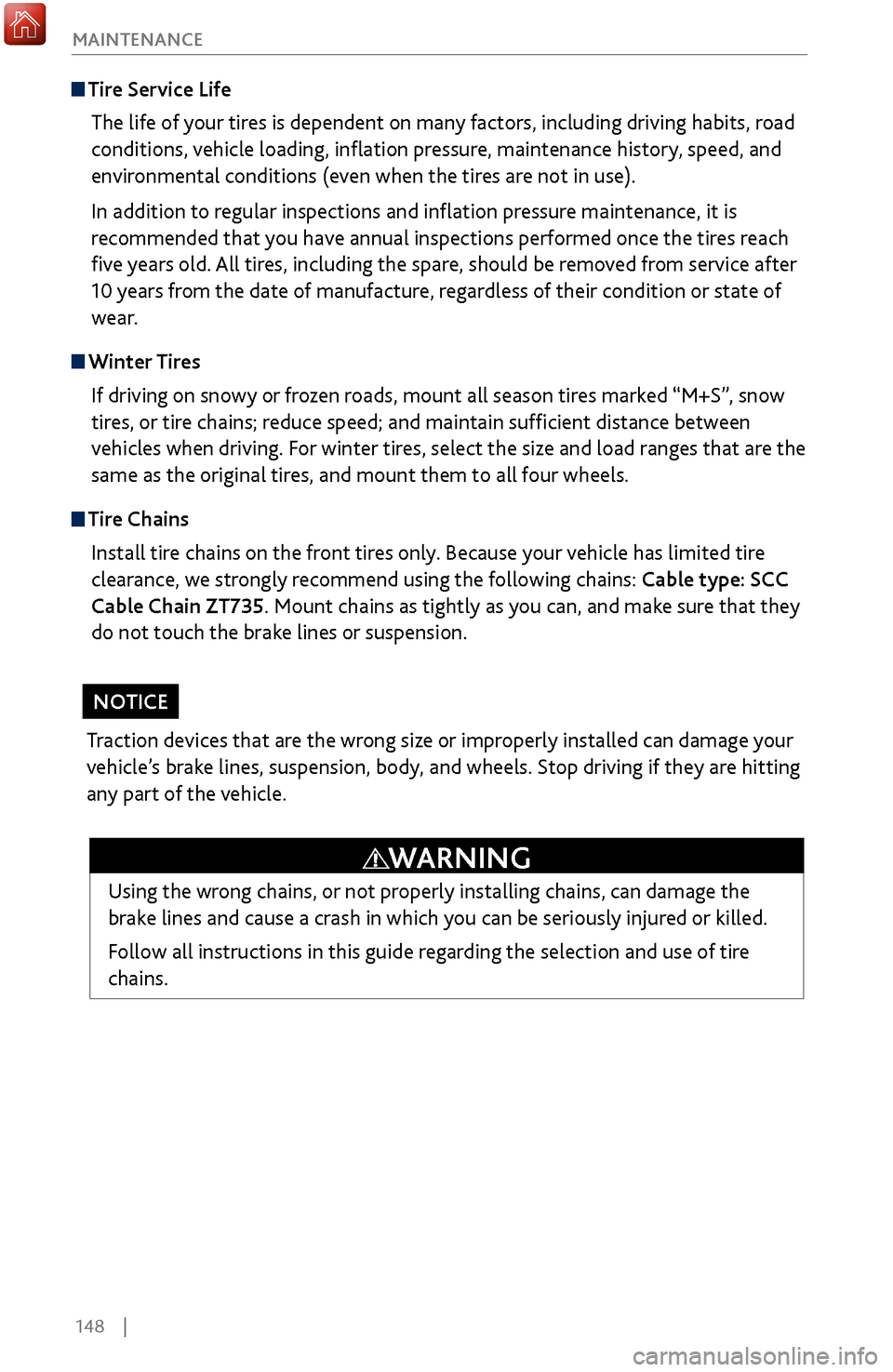
148 |
MAINTENANCE
Tire Service Life
The life of your tires is dependent on many factors, including driving habits, road
conditions, vehicle loading, inflation pressure, maintenance history, speed, and
environmental conditions (even when the tires are not in use).
In addition to regular inspections and inflation pressure maintenance, it is
recommended that you have annual inspections performed once the tires reach
five years old. All tires, including the spare, should be removed from service after
10 years from the date of manufacture, regardless of their condition or state of
wear.
Winter Tires
If driving on snowy or frozen roads, mount all season tires marked “M+S”, snow
tires, or tire chains; reduce speed; and maintain sufficient distance between
vehicles when driving. For winter tires, select the size and load ranges that are the
same as the original tires, and mount them to all four wheels.
Tire Chains
Install tire chains on the front tires only. Because your vehicle has limited tire
clearance, we strongly recommend using the following chains: Cable type: SCC
Cable Chain ZT735. Mount chains as tightly as you can, and make sure that they
do not touch the brake lines or suspension.
Using the wrong chains, or not properly installing chains, can damage the
brake lines and cause a crash in which you can be seriously injured or killed.
Follow all instructions in this guide regarding the selection and use of tire
chains.
WARNING
Traction devices that are the wrong size or improperly installed can damage your
vehicle’s brake lines, suspension, body, and wheels. Stop driving if they are hitting
any part of the vehicle.
NOTICE
Page 156 of 170
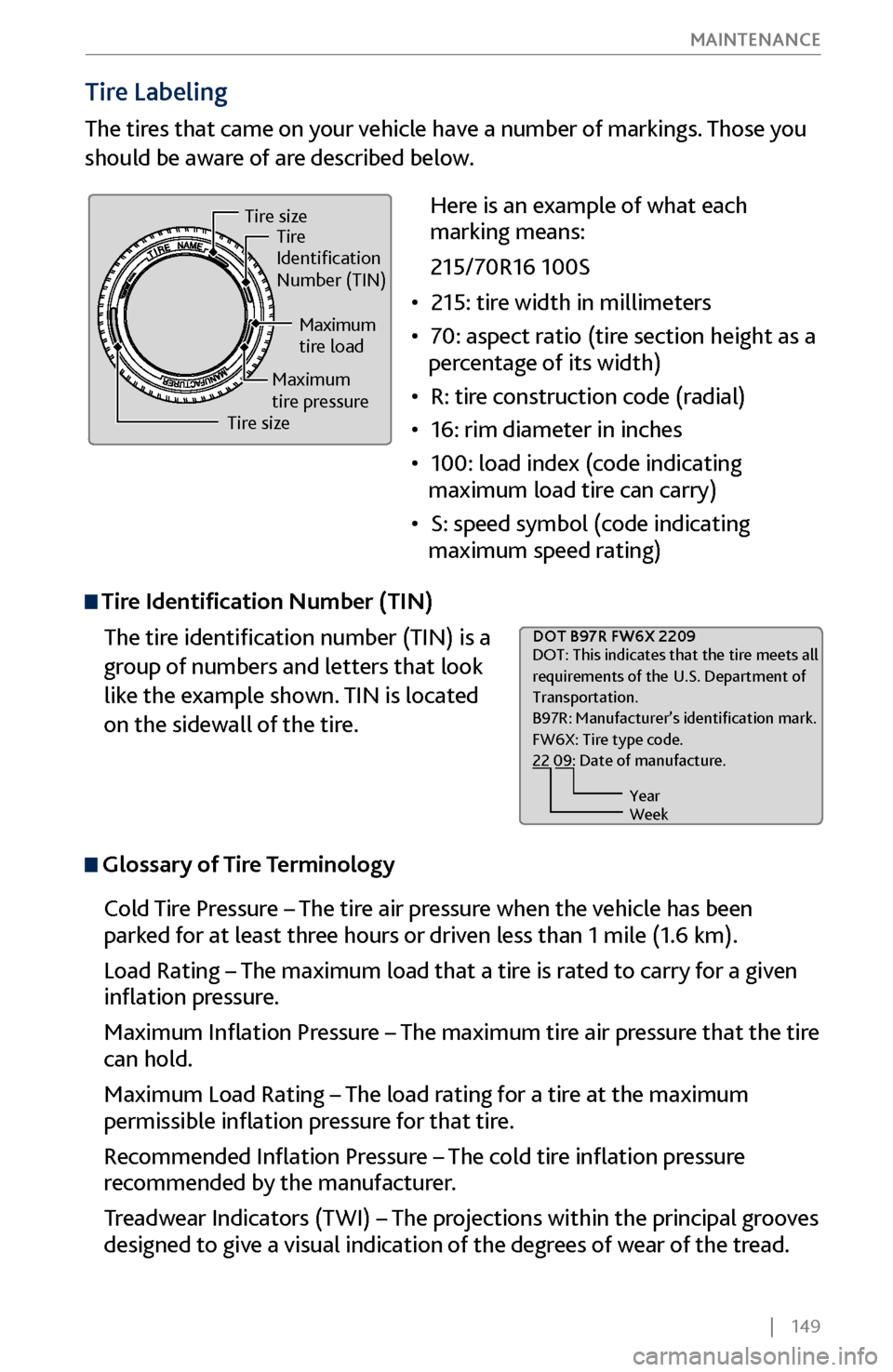
| 149
MAINTENANCE
Tire Labeling
The tires that came on your vehicle have a number of markings. Those you
should be aware of are described below.
Tire Identification Number (TIN)
The tire identification number (TIN) is a
group of numbers and letters that look
like the example shown. TIN is located
on the sidewall of the tire.
Glossary of Tire Terminology
Cold Tire Pressure – The tire air pressure when the vehicle has been
parked for at least three hours or driven less than 1 mile (1.6 km).
Load Rating – The maximum load that a tire is rated to carry for a given
inflation pressure.
Maximum Inflation Pressure – The maximum tire air pressure that the tire
can hold.
Maximum Load Rating – The load rating for a tire at the maximum
permissible inflation pressure for that tire.
Recommended Inflation Pressure – The cold tire inflation pressure
recommended by the manufacturer.
Treadwear Indicators (TWI) – The projections within the principal grooves
designed to give a visual indication of the degrees of wear of the tread.
DO T B97R FW6X 2209
DOT: This indicates that the tire meets all
requirements of the U.S. Department of
Transportation.
B97R: Manufacturer’s identi�cation mark.
FW6X: Tire type code.
22 09: Date of manufacture.
Year
Week
Here is an example of what each
marking means:
215/70R16 100S
•
215: tire
width in millimeters
•
70: aspect ratio (tire section height as a
per
centage of its width)
•
R: tire construction code (radial)
•
16: rim diameter in inches
•
100: load index (code indicating
maximum load tire can carry)
•
S: speed symbol (code indicating
maximum speed rating)
Tire size Tire
Identi�cation
Number (TIN)
Maximum
tire load
Maximum
tire pressure
Tire size
Page 160 of 170
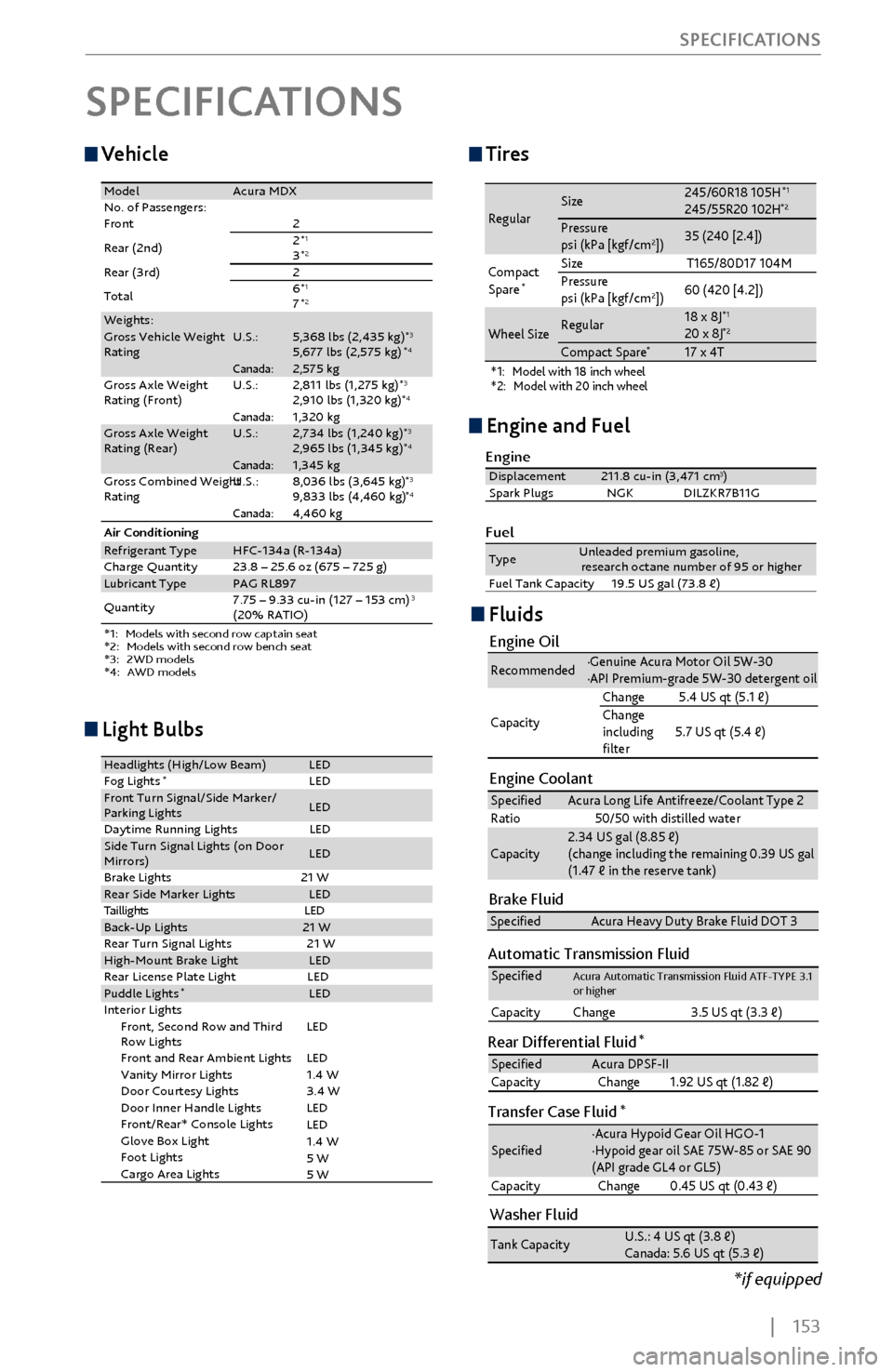
| 153
SPECIFICATIONS
Vehicle
*
*
1: Models with second row captain seat
* 2: Models with second row bench seat
* 3: 2WD models
4: AWD models
ModelAcura MDX
Front No. of Passengers: 2
12*
2Rear (2nd) 3*2
Rear (3rd)1Tota l 6*
27*Weights:
RatingGross Vehicle Weight U.S.:5,368 lbs (2,435 kg)*3
Gross Axle Weight 5,677 lbs (2,575 kg
)
*4Canada:2,575 kg
Rating (Front)U.S.: 2,811 lbs (1,275 kg)*3
Gross Axle Weight 2,910 lbs (1,320 kg
)
*4Canada:1,320 kg
Rating (Rear)U.S.: 2,734 lbs (1,240 kg)*3
Gross Combined Weight
Rating U.S.
: 2,965 lbs (1,345 kg)
*4Canada
:1,345 kg
8,036 lbs (3,645 kg )*39,833 lbs (4,460 kg)*4Canada:4,460 kg
Refrigerant Type
Charge Quantity
Lubricant TypeQuantity
HFC-134a (R-134a )
23.8 – 25.6 oz (675 – 725 g )
PAG RL89 7
7.75 – 9.33 cu-in (127 – 153 cm
3)
(20% RATIO )
Air Conditioning Fluids
Engine Oi
l
Engine Coolan t
Recommended·Genuine Acura Motor Oil 5W-3 0
·API Premium-grade 5W-30 detergent oi l
Capacity Change
5.4 US qt (5.1 �)
Change
including
�lter 5.7 US qt (5.4 �)
Speci�e
dAcura Long Life Antifreeze/Coolant Type 2
Ratio 50/50 with distilled wate r
Capacity2.34 US gal (8.85 �)
(change including the remaining 0.39 US gal
(1.47 � in the reserve tank )
Washer Fluid
Tank CapacityU.S.: 4 US qt (3.8 �)
Canada: 5.6 US qt (5.3 �)
Brake FluidSpeci�edAcura Heavy Duty Brake Fluid DOT 3
Automatic Transmission Fluid
Rear Differential Fluid*
Transfer Case Fluid*
Speci�edAcura Automatic Transmission Fluid ATF-TYPE 3. 1
or higher
Capacity Change 3.5 US qt (3.3 �)
Speci�edAcura DPSF-II
Capacity Chang e1.92 US qt (1.82 �)
Speci�e d·Acura Hypoid Gear Oil HGO-1
·Hypoid gear oil SAE 75W-85 or SAE 90
(API grade GL4 or GL5)
Capacity Chang e0.45 US qt (0.43 �)
SPECIFICATIONS
Tires
*1:Model with 18 inch wheel*2: Model with 20 inch wheel
RegularSize245/60R18 105H*1245/55R20 102 H*2Pressure
psi (kPa [kgf/cm2])35 (240 [2.4])
Compact
Spar e
*Size T165/80D17 104M
Pressure
psi (kPa [kgf/cm
2]) 60 (420 [4.2])
Wheel SizeRegula
r18 x 8J*120 x 8J*2Compact Spar e*17 x 4T
Engine and Fuel
Engine
FuelDisplacement211.8 cu-in (3,471 cm3)
Spark Plugs NGKD ILZKR7B11G
TypeUnleaded premium gasoline,
research octane number of 95 or higher
Fuel Tank Capacity 19.5 US gal (73.8 �)
Light Bulbs
Headlights (High/Low Beam )LED
Fog Lights*LE DFront Turn Signal/Side Marker /
Parking Lights
Daytime Running Lights LEDSide Turn Signal Lights (on Door
Mirrors )LED
Brake Lights 21 W
Rear Side Marker Light sLED
DEL
sthgilliaT
Back-Up Lights21 W
Rear Turn Signal Lights 21 W
High-M ount Brake Ligh tLED
Rear License Plate Light LED
Puddle Lights*LED
In teri or Lights
Front, Second Row and Third
Row Lights
Front and Rear Ambient Lights
Vanity Mirror Lights
Door Courtesy Lights
Door Inner Handle Lights
Front/Rear* Console Lights
Glove Box Ligh t
Foot Lights
Cargo Area Lights
LE D
1.4 W
3.4 W LE D
LE
D
LED 1.4 W
5 W
5 W
LE
D
*if equipped